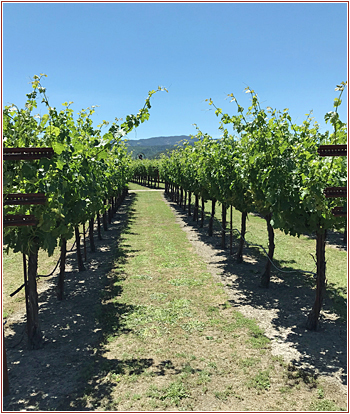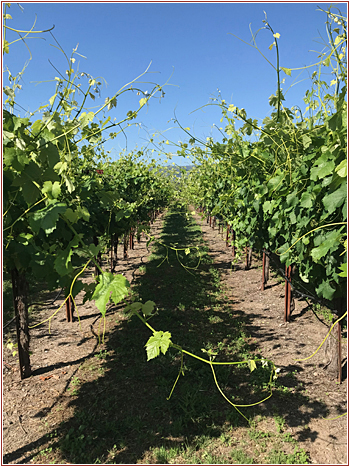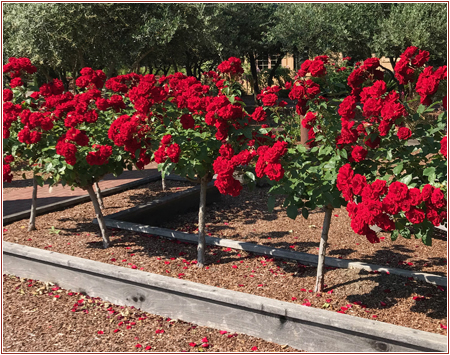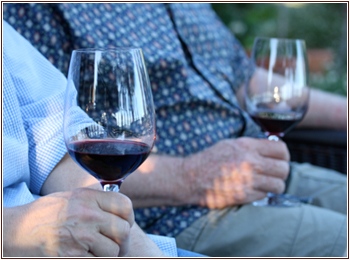
Tom Scott Vineyard Newsletter - Summer 2019 - Barn Burner Cabernet Sauvignon

Years from now when we talk about our 2019 Barn Burner vintage, the word "vigorous" will tell the whole story!
 We started the season later than usual this year. Our practice has been to begin pruning on February 14th, but this year we began cutting canes on March 1st. We never cut the canes while the vine is dormant, to avoid exposing the plant to a virus entering through the new cut. Once the vine gets the sap flowing, pruning no longer poses a risk. This year with the cool spring, the vines were very slow to wake up! We started the season later than usual this year. Our practice has been to begin pruning on February 14th, but this year we began cutting canes on March 1st. We never cut the canes while the vine is dormant, to avoid exposing the plant to a virus entering through the new cut. Once the vine gets the sap flowing, pruning no longer poses a risk. This year with the cool spring, the vines were very slow to wake up!
We noticed at once how much growth the vines had produced last year. Many vines that had never before produced exceptional growth, did so in 2018, giving us a very large canopy to prune. We added a fifth fruiting cane to many vines in areas that had never before needed that extra balancing. And our vines are 19 years old now, clearly just hitting their stride!
After four years of extreme drought (2011 to 2015) - the vines appear to have fully recovered. This season (June to June) we had approximately 41 inches of rain. Rain usually comes in the winter and early spring months. This year we had relatively heavy rain continue through May, with 1.6 inches arriving on May 16th alone! Luckily, the late rains had only a slight impact on bloom and set. If heavy rain falls while the vines have flowers, they may suffer damage. The flowers need to open and a "cap" fall off, which allows the stamens to spread and self-pollinate, creating berries. If too much moisture causes the cap to stick and not fall off, the berry will not develop. When this happens, instead of grapes, you get small hard BB-like balls, which are called "shot berries."
 Recent canopy growth has been quick and huge. In normal years, we hedge the canopy, as long canes reach out and attach themselves to canes across the vine row. The linked canes then create an arch, and while it looks beautiful, it interferes with our tractors getting through to spray and mow. By this time of year, we've usually had to hedge once, but the growth has been so vigorous this season, that we've had to hedge twice. Recent canopy growth has been quick and huge. In normal years, we hedge the canopy, as long canes reach out and attach themselves to canes across the vine row. The linked canes then create an arch, and while it looks beautiful, it interferes with our tractors getting through to spray and mow. By this time of year, we've usually had to hedge once, but the growth has been so vigorous this season, that we've had to hedge twice.
Between now and August, in order to keep the mildew risk low, Tom will continue to spray the vineyard. He sprays about every 10 to 14 days, but that schedule can be affected by both rain and heat, so it varies. Lauren will continue to mow the vineyard and grounds weekly. Like the vineyard, the chicory is particularly vigorous!
The fruit is developing and the canopy (cane growth) continues. By August, the canes will stop growing and the vine will focus on ripening the fruit. As the berries add sugar, they become naturally resistant to mildew, at which point, Tom can stop spraying. At that time, we will bring a crew in to help us drop (remove) 20 to 40% of our fruit. Thinning the amount of fruit on the vine, by removing bunches, allows the remaining berries to fully ripen, helping us achieve another exceptional harvest.
By the way, the fruit we remove is taken to be composted, and our spray program is always organic!
We've decided to add a comment or two in each of our Notes from the Vineyard that addresses certain vineyard myths. We still have to come up with a cute name for the feature... but we're open to suggestions!
 This time we thought we'd write about something we often get asked about... "Why are rose bushes planted at the end of vine rows in some vineyards?" This time we thought we'd write about something we often get asked about... "Why are rose bushes planted at the end of vine rows in some vineyards?"
We've heard what our visitors have been told at other vineyards, and we are often surprised. Roses and grapes grow and thrive in very similar conditions; they do well in the same type of weather and soil. Long ago, roses were planted as an early warning system for mildew. But viticulture has come a long way since then, and one of the things we know now, is that the mildew that effects roses is a different type of mildew than that which effects vines. In fact, the mildew that can damage vines is only found on grape vines. Over the winter, mildew on dormant canes, is always present. Spray programs are only used to keep it in check - not eliminate it. If you waited for mildew to appear on other plants in the vicinity of vines, it would be too late for your treatment program to stop the spreading mildew on the grape vines.
We've also heard that the roses impart some essence to the berries, which then presents in the nose or flavors of wine! To this... we offer a resounding NO!
Roses are in fact beautiful, and add to the beauty of vineyards and the Napa Valley over all. So, thank you to everyone that plants roses in vineyards, because we appreciate beauty!
If you have a question or comment that we can address in our future Notes, please don't hesitate to reach out to us.
Not only is the vineyard vigorous, but all of our gardens have blasted off as well! Our flowers, veggies and trees are putting on quite a show, and each evening we sit in wonder and raise a glass to the good life.
A happy summer to you all!
 Tom and Lauren Scott
www.tomscottvineyard.com
www.tomscottvineyard.com/wineshop
info@tomscottvineyard.com
Back-issues of our Notes

|



